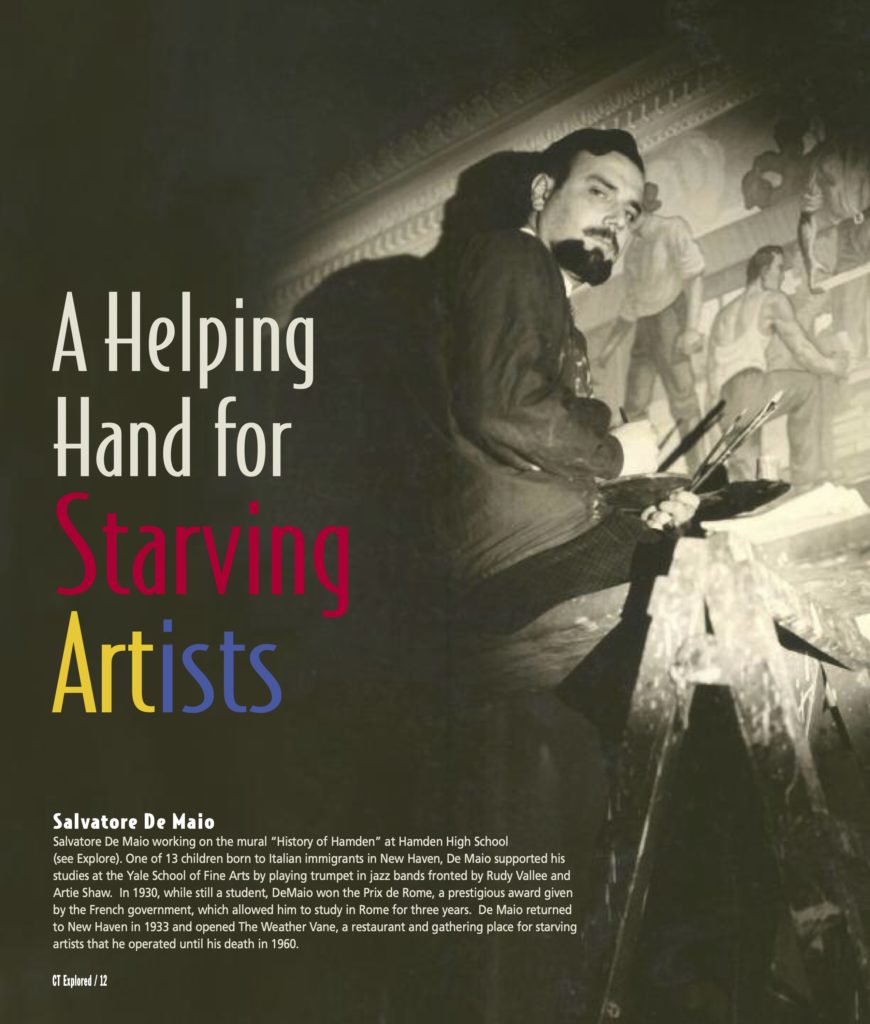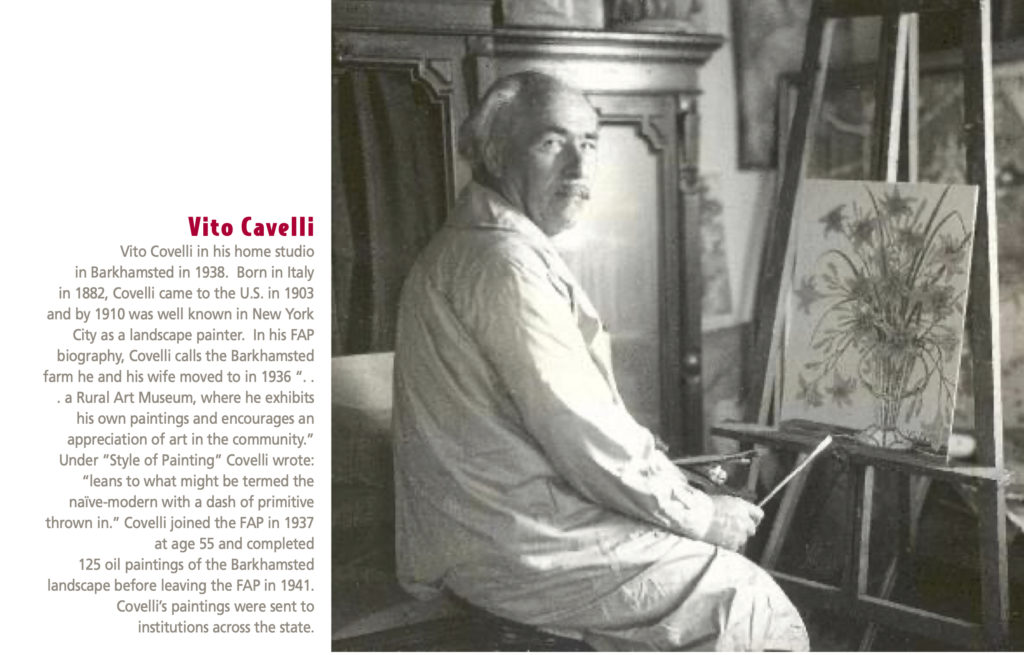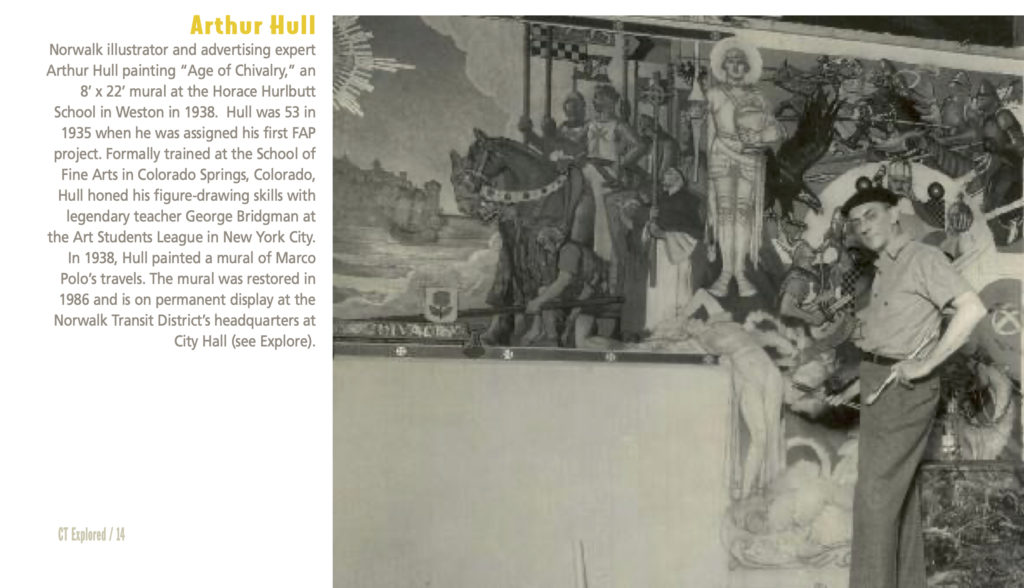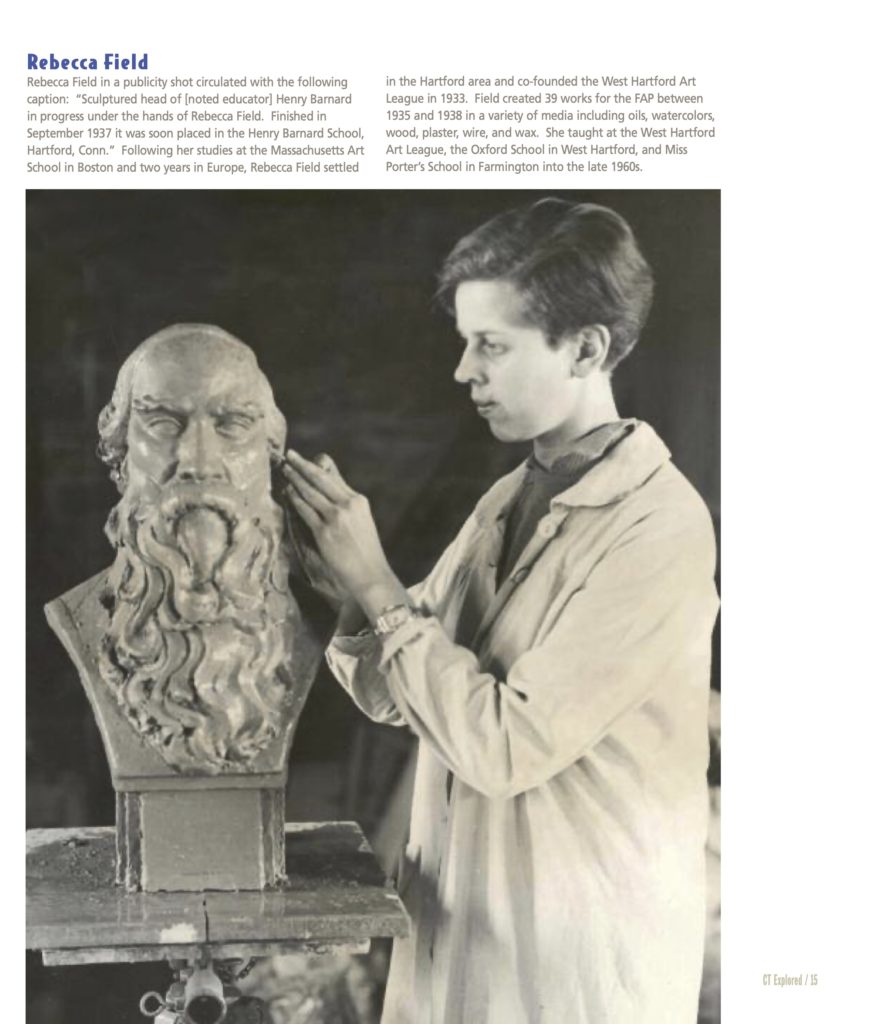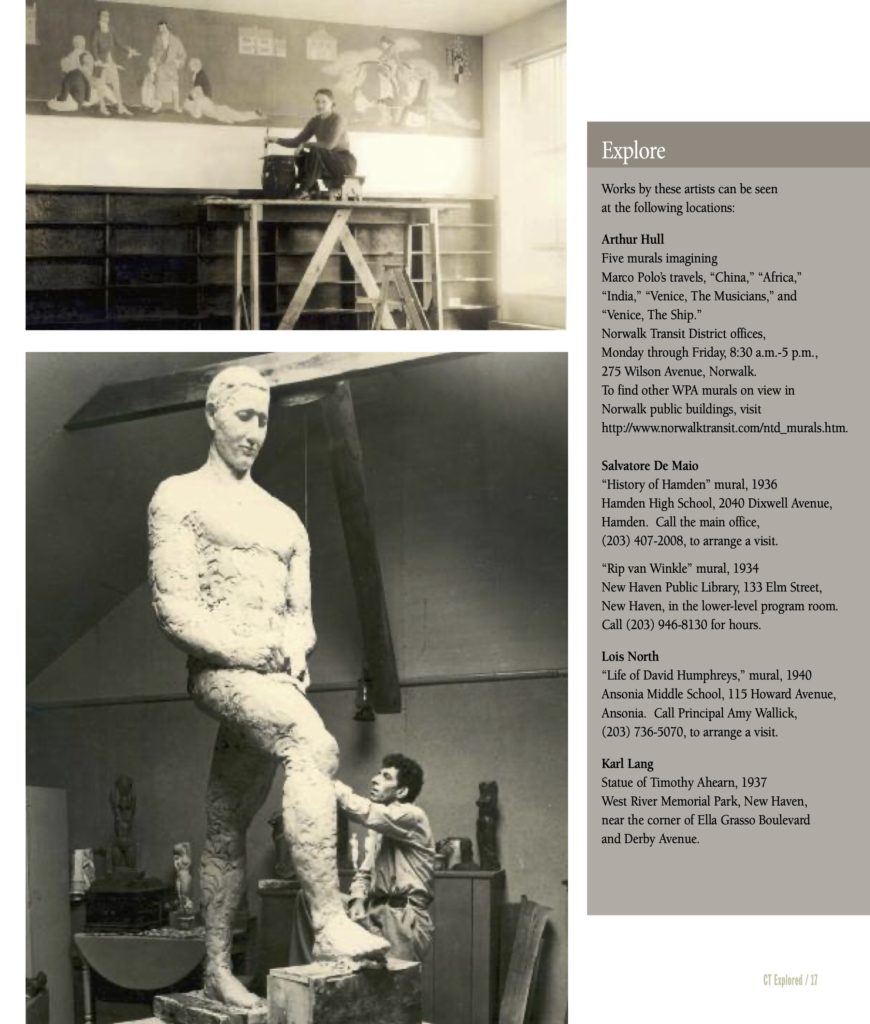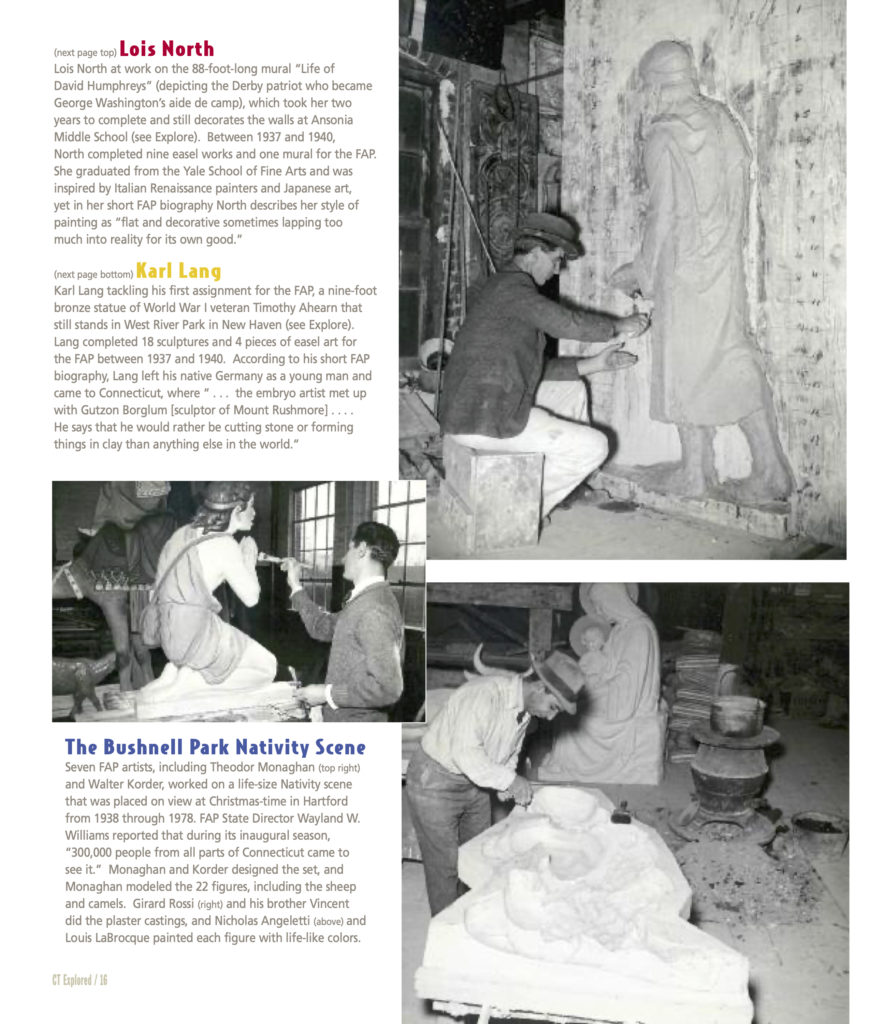By Mark Jones and Diane Pflugrad Foley
(c) Connecticut Explored Inc. Spring 2010
Subscribe/Buy the Issue!
When historian Amy Trout wrote for this magazine about the struggles artists faced during the Great Depression and the relief many of them found in the Federal Art Project (FAP), a program of the federal Works Progress Administration aimed at providing employment for visual artists [“The Federal Art Project: The Era, Art and Legacy“, Winter 2006/2007], she noted that “There is an increasing awareness that these works of art were created from a unique program in American history and carry with them cultural content about . . . American life during the Depression.”
Trout’s article caught the eye of Connecticut State Representative David McCluskey of West Hartford, who was moved by her call to create a “definitive catalogue of Connecticut Federal Art Project artists and their artwork.” McCluskey’s efforts led to the 2007 General Assembly’s appropriating funds that were used to underwrite the WPA Art Inventory Project at the Connecticut State Library.
State Archivist Mark Jones, the project’s coordinator, began by evaluating the state library’s existing holdings: “Work production” cards, short biographies, black-and-white photographs, reports, and other materials documenting the activities of more than 170 artists who worked in Connecticut between 1935 and 1942 under the Federal Arts Project. He estimates that these artists—and others now unknown—created 5,000 works, including murals, paintings, photographs, crafts, photographs, and more.
Work production cards list the locations, such as schools and hospitals, where some of the works had been placed including Long Lane Farm (a home for wayward boys and girls) in Middletown, Cedarcrest Sanatorium in Hartford, and the Soldier’s Home in Rocky Hill. Other pieces went to members of Connecticut’s Congressional delegation in Washington, and as World War II escalated, many pieces went out to military installations.
Work production cards also give artists’ home addresses and the dates of their tenure with the FAP. More details of the artists’ lives are found in FAP newsletters and brief biographies the artists wrote themselves with notes on “Personal History,” “Art Career,” and “Style.” The library’s collections also included more than 1,500 black-and-white documentary photographs taken by three FAP photographers. Some of these simply show pieces of art, but others show artists in their studios or at work on large murals in public buildings. The FAP used these photos to publicize the artists’ work and involve the community with projects underway.
Jones, along with project assistants Damon Munz and Nolan Pelletier, entered data from artist work cards into an extensive database, matched photographs with artists and their work, and researched the artists’ lives to complete biographies that extend beyond the FAP’s original documentation. The photographs and captions that follow give a taste of what can be found on the project’s Web site: https://ctstatelibrary.org/wpa-art-inventory/.
The WPA Art Inventory Project also has made an effort to track down FAP projects that have not yet been documented. Last spring the project sent a poster featuring FAP art and artists to institutions and individuals across the state and asked recipients to post it in a public area to encourage “questions, stories, remembrances and recent sightings.” The goal was twofold: To locate more examples of the estimated 5,000 pieces of art produced under the FAP and to learn more about the less known or unknown artists who participated in the program. Additional funding received from the Connecticut Humanities Council allows the project to culminate with an exhibition of FAP art at the Mattatuck Museum this fall.
On the following pages we present images of artists at work during the Depression, now accessible to many as the remarkable outgrowth of a project spurred by Amy Trout’s article.
TOP: Salvatore De Maio
Salvatore De Maio working on the mural “History of Hamden” at Hamden High School (see Explore). One of 13 children born to Italian immigrants in New Haven, De Maio supported his studies at the Yale School of Fine Arts by playing trumpet in jazz bands fronted by Rudy Vallee and Artie Shaw. In 1930, while still a student, DeMaio won the Prix de Rome, a prestigious award given by the French government, which allowed him to study in Rome for three years. De Maio returned to New Haven in 1933 and opened The Weather Vane, a restaurant and gathering place for starving artists that he operated until his death in 1960.
Vito Covelli in his home studio in Barkhamsted in 1938. Born in Italy in 1882, Vito Covelli came to the U.S. in 1903 and by 1910 was well known in New York City as a landscape painter. In his FAP biography, Covelli calls the Barkhamsted farm he and his wife moved to in 1936 “. . . a Rural Art Museum, where he exhibits his own paintings and encourages an appreciation of art in the community.” Under ‘\”Style of Painting” Covelli wrote: “leans to what might be termed the naïve-modern with a dash of primitive thrown in.” Covelli joined the FAP in 1937 at age 55 and completed 125 oil paintings of the Barkhamsted landscape before leaving the FAP in 1941. Covelli’s paintings were sent to institutions across the state.
Arthur Hull
Norwalk illustrator and advertising expert Arthur Hull painting “Age of Chivalry,” an 8’ x 22’ mural at the Horace Hurlbutt School in Weston in 1938. Hull was 53 when assigned his first FAP project in 1935. Formally trained at the School of Fine Arts in Colorado Springs, Colorado, Hull honed his figure-drawing skills with legendary teacher George Bridgman at the Art Students League in New York City. In 1938, Hull painted a mural of Marco Polo’s travels, which was restored in 1986 and is on permanent display at the Norwalk Transit District’s headquarters at City Hall (see Explore).
Rebecca Field
Rebecca Field in a publicity shot circulated with the following caption: “Sculptured head of Henry Barnard [noted educator]in progress under the hands of Rebecca Field. Finished in September 1937 it was soon placed in the Henry Barnard School, Hartford, Conn.” Following her studies at the Massachusetts Art School in Boston and two years in Europe, Rebecca Field settled in the Hartford area and co-founded the West Hartford Art League in 1933. Field created 39 works for the FAP between 1935 and 1938 in a variety of media including oils, watercolors, wood, plaster, wire, and wax. She taught at the West Hartford Art League, the Oxford School in West Hartford, and Miss Porter’s School in Farmington into the late 1960s.
Lois North
Lois North at work on the 88-foot-long mural Life of David Humphreys (a Derby patriot who became George Washington’s aide de camp), which took her two years to complete and still decorates the walls at Ansonia Middle School (see Explore). Between 1937 and 1940, Lois North completed nine easel works and one mural for the FAP. North graduated from the Yale School of Fine Arts and was inspired by Italian Renaissance painters and Japanese art, yet in her short FAP biography North describes her style of painting as “flat and decorative sometimes lapping too much into reality for its own good.”
Karl Lang
Karl Lang tackling his first assignment for the FAP, a nine-foot bronze statue of World War I veteran Timothy Ahearn that still stands in West River Park in New Haven (see Explore). Lang completed 18 sculptures and 4 pieces of easel art for the FAP between 1937 and 1940. According to his short FAP biography, Lang left his native Germany as a young man and came to Connecticut, where “ . . . the embryo artist met up with Gutzon Borglum [sculptor of Mount Rushmore]. . . . He says that he would rather be cutting stone or forming things in clay than anything else in the world.”
The Bushnell Park Nativity Scene
Seven FAP artists, including Theodor Monaghan (top right) and Walter Korder, worked on a life-size Nativity scene that was placed on view at Christmas-time in Hartford, from 1938 through 1978. FAP State Director Wayland W. Williams reported that during its inaugural season, “300,000 people from all parts of Connecticut came to see it.” Monaghan and Walter Korder designed the set, and Monaghan modeled the 22 figures including the sheep and camels. Girard Rossi (middle right) and brother Vincent did the plaster castings, and Nicholas Angeletti (bottom right) and Louis LaBrocque painted each figure with life-like colors.
Explore!
Read more stories about Connecticut’s Art History on our TOPICS page.
Works by artists above can be seen at the following locations:
Arthur Hull
Arthur Hull’s five murals imagining Marco Polo’s travels, “China,” “Africa,” “India,” “Venice the Musicians,” and “Venice, The Ship Norwalk Transit District offices, 275 Wilson Avenue, Norwalk. To find other WPA murals on view in Norwalk public buildings, visit https://www.norwalktransit.com/wpamurals.
Salvatore De Maio
“History of Hamden” mural, 1936, Hamden High School, 2040 Dixwell Avenue, Hamden. Call the main office, (203) 407-2008, to arrange a visit.
“Rip van Winkle” mural, 1934, New Haven Public Library, 133 Elm Street, New Haven, in the lower-level program room. Call (203) 946-8130 for hours.
Lois North
“Life of David Humphreys,” mural, 1940, Ansonia Middle School, 115 Howard Avenue, Ansonia. Call Principal Amy Wallick, (203) 736-5070, to arrange a visit.
Karl Lang
Statue of Timothy Ahearn, 1937, New Haven’s West River Memorial Park, near the corner of Ella Grasso Boulevard and Derby Avenue.

